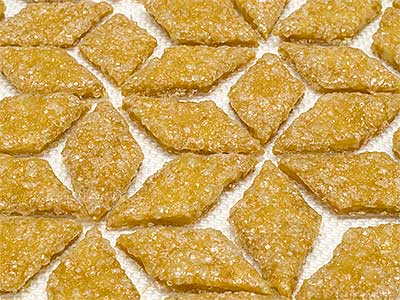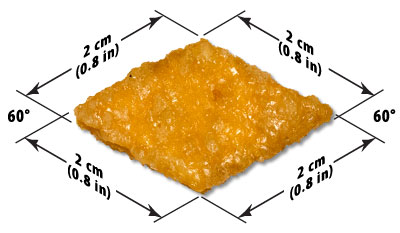April 8, 2013
Mignardise

diamants de cristal
(crystal diamonds)
I could live very nicely if I never again heard some chef or cooking teacher repeat “cooking is an art, baking is a science.” They commonly follow-up the statement with how cooking uses recipes and baking uses formulas, as if the name given to the preparation prescription separates science from art. The actual quote is generally credited to a 1967 King Arthur Flour Company catalog, although I haven’t seen the actual catalog.
Cooking is both an art and a science
is credited to Sir Malcolm Alexander Morris in The Book of Health (1883). I think Morris’ whole quote is quite instructive.
Cooking is both an art and a science, and good cooking implies both knowledge and skill. A cook need not be either a chemist or physiologist, any more than a philosopher; but he must have a certain amount of skill, acquired for himself by practice and experimental knowledge. Of the philosophy of his art he may have very little knowledge or comprehension, but his skill will be unavailing if it be exercised regardless of the teachings of science.
And of course there is the corollary.
Baking is both an art and a science.
In 1949, Jack Myer, an application engineer for the Brown Instruments Division of the Minneapolis-Honeywell Regulator Company of Philadelphia wrote in the Baker’s Digest
Baking is both an art and a science. Baking art derives from traditional skill and empirical knowledge, whereas baking science rests upon a foundation of modern technology. Process instrumentation and control are of equal value in both art and science.
I can agree with both Morris and Myer, but I find the anonymous author of the flour catalog a bit extreme. I do not think the separation of cooking and baking, or the explanation, is that simple.
I consider myself more of a cook than a baker, though I can muddle through with both. I find the science of cooking easier to comprehend than the science of baking, even though the latter’s science is probably less complicated.
I cook every day, I only bake occasionally. In some ways this is strange because, with my science and engineering background, I am probably more comfortable with the “precise” measurements of baking versus the approximations of cooking. By this point in my life I have enough experience to let my inner navigational controls drive my cooking, but I still need a calibrated GPS for baking.
On October 14th, 2012, there was a short posting on the food blog Ideas in Food titled Arnhem Biscuits. (I already knew Arnhem as a stop along the train route from Amsterdam to Nijmegen, a run I made many times in the 1990s. It was also the site of a famous World War II battle in September 1944. And biscuits, or course, is the British term for cookies.) The blog linked to a 2008 posting at the King Arthur website called Sparkle-icious. This, in turn, linked to a recipe for some cookies called Crystal Diamonds. And these cookies are very similar to Arnhemse Meisjes, literally “girls from the city of Arnhem.” After making the rounds through the various websites, I decided that even though baking isn’t my strong suit, I’d give these a try.
Starting with the recipe from King Arthur, I first reduced the ingredient quantities by half. Since my goal was mignardise, my cookies would be only half the size of those in the recipe, I still had the potential of producing up to 10 dozen cookies in a single batch, enough for more than a few years of dinner guests. Making half the original recipe produced 6 dozen finished cookies, each about 2 cm (0.8 in) per side after a generous sacrificing of all the less than perfect ones and the raw dough scraps to the tasting gods.
After making the recipe all the way through, I don’t think halving it further would produce successful results. There would be too little dough for the mixer to properly incorporate the butter.
The rolled out and cut dough can be quite soft. If possible, place it in the refrigerator to firm it again before attempting to transfer it baking sheets.
1⁄2 t
active dry yeast
65 ml (2-1⁄4 fl oz)
milk at 40 to 46 °C (104 to 115 °F)
90 g (3⁄4 c)
all-purpose flour
2 drops
lemon oil
1⁄4 t
fine salt
58 g (1⁄4 c)
butter, cut into 4 pieces
120 to 180 g (4 to 6 oz)
very coarse Turbinado sugar
1. Add the yeast to the milk. Give it a few minutes to dissolve and disperse. Place the milk mixture along with the flour, lemon oil, and salt in the bowl of a stand mixer fitted with a paddle. Beat at low speed until combined.
2. Add a piece of butter to the mixer bowl, increase the speed slightly, and mix for a full minute. The butter should be fully incorporated and the dough smooth. Repeat the process and timing with the remaining three pieces of butter. Gather the dough into a ball, place into a small bowl, cover the bowl with plastic wrap, and refrigerate the dough for a few hours until quite chilled, or overnight.
3. Preheat your oven to 135 °C (275 °F).
4. Sprinkle your work surface with a coating of some of the sugar. Flatten the dough into a disc, and press both sides into the sugar. Roll the dough into a 2 mm (0.08 in) thick rectangle. As you roll out the dough, keep sprinkling it with sugar and pressing the sugar into both surfaces of the dough.

5. Using a pizza wheel and a long, metal straightedge, cut the dough into diamonds. Each diamond should be about 2 cm (0.8 in) per side, and the narrow angles should be about 60°. Chill the cut pieces.
6. Transfer the chilled pieces to a baking sheet lined with a silicone-rubber coated baking mat. The cookies shouldn’t be touching, but since they shrink when cooked, additional spacing around the cookies is not required.
7. Place the cookie sheet in your oven. Bake until the cookies are a deeply golden brown, about an 60 minutes.
8. Transfer the baked cookies to a cooling rack as soon as they are removed from the oven.
9. After the cookies have cooled fully, freeze those that you do not plan to eat in the next couple of days.
© 2013 Peter Hertzmann. All rights reserved.
